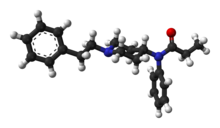Fentanyl citrate
 |
|
 |
|
| Clinical data | |
|---|---|
| Trade names | Actiq, Duragesic, Fentora, others |
| AHFS/Drugs.com | Monograph |
| License data | |
| Pregnancy category |
|
| Dependence liability |
Very high |
| Routes of administration |
Buccal, epidural, IM, IT, IV, sublingual, skin patch |
| Drug class | Opioid |
| ATC code | |
| Legal status | |
| Legal status |
|
| Pharmacokinetic data | |
| Bioavailability | 92% (transdermal) 89% (intranasal) 50% (buccal) 33% (ingestion) |
| Protein binding | 80–85% |
| Metabolism | hepatic, primarily by CYP3A4 |
| Onset of action | 5 minutes |
| Biological half-life |
IV: 6 mins (T1/2 α) 1 hours (T1/2 β) 16 hours (T1/2 ɣ) Intranasal: 6.5 hours Transdermal: 20–27 hours Sublingual/buccal (single dose): 2.6–13.5 hours |
| Duration of action | IV: 30–60 minutes |
| Excretion | Mostly urinary (metabolites, <10% unchanged drug) |
| Identifiers | |
|
|
| CAS Number | |
| PubChem CID | |
| IUPHAR/BPS | |
| DrugBank | |
| ChemSpider | |
| UNII | |
| KEGG | |
| ChEBI | |
| ChEMBL | |
| ECHA InfoCard | 100.006.468 |
| Chemical and physical data | |
| Formula | C22H28N2O |
| Molar mass | 336.471 g/mol |
| 3D model (JSmol) | |
| Melting point | 87.5 °C (189.5 °F) |
|
|
|
|
Fentanyl, also known as fentanil, is an opioid which is used as a pain medication and together with other medications for anesthesia. It has a rapid onset and effects generally last less than an hour or two. Fentanyl is available in a number of forms including by injection, as a skin patch, and to be absorbed through the tissues inside the mouth.
Common side effects include nausea, constipation, sleepiness, and confusion. Serious side effects may include a decreased effort to breathe (respiratory depression), serotonin syndrome, low blood pressure, or addiction. Fentanyl works in part by activating μ-opioid receptors. It is about 75 times stronger than morphine for a given amount. Some fentanyl analogues may be as much as 10,000 times stronger than morphine.
Fentanyl was first made by Paul Janssen in 1960 and approved for medical use in the United States in 1968. It was developed by testing chemicals similar in structure to pethidine (meperidine) for opioid activity. In 2015, 1,600 kilograms (3,500 lb) were used globally. As of 2017[update], fentanyl was the most widely used synthetic opioid in medicine.
Fentanyl patches are on the World Health Organization's List of Essential Medicines, the most effective and safe medicines needed in a health system. The wholesale cost in the developing world as of 2015 is between 0.08 and 0.81 USD per 100 micrograms vial. In the United States this amount costs about 0.40 USD as of 2017. Fentanyl is also made illegally and used as a recreational drug often mixed with heroin or cocaine. In 2016 more than 20,000 deaths occurred in the United States due to overdoses of fentanyl and its analogues.
...
Wikipedia
